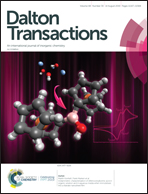Long magnetic relaxation time of tetracoordinate Co2+ in imidazo[1,5-a]pyridinium-based (C13H12N3)2[CoCl4] hybrid salt and [Co(C13H12N3)Cl3] molecular complex†
Abstract
The novel organic-inorganic hybrid salt [L]2[CoCl4] (1) and molecular complex [CoLCl3] (2), where L+ is 2-methyl-3-(pyridin-2-yl)imidazo[1,5-a]pyridinium cation, feature simple {CoCl4} and {CoCl3N} tetrahedral environments of negligible (1) and a slightly higher distortion (2) that are responsible for rather low positive magnetic anisotropy of CoII ion with D/hc = 12.1(6) (1) and 19.4(15) cm−1 (2). Both compounds exhibit field-induced slow magnetic relaxation with three relaxation channels [low- (LF), intermediate- and high-frequency (HF) modes] that is frequency and field dependent. With the increased DC field, the peaks referring to the LF relaxation path are moved to lower frequencies so that the applied DC field causes prolongation of the relaxation time. The opposite is true for the HF relaxation branch: the peak is moved to higher frequencies. Considering the simplicity of the coordination environment and moderate magnetic anisotropy of the metal ion in 1 and 2, the compounds are unique with respect to the remarkably long relaxation time for a given applied DC field and temperature: τLF = 0.54(4) s at BDC = 1.0 T and T = 2.0 K for 1, and τLF = 1.8(2) s at BDC = 1.2 T and T = 1.9 K for 2.
![Graphical abstract: Long magnetic relaxation time of tetracoordinate Co2+ in imidazo[1,5-a]pyridinium-based (C13H12N3)2[CoCl4] hybrid salt and [Co(C13H12N3)Cl3] molecular complex](/en/Image/Get?imageInfo.ImageType=GA&imageInfo.ImageIdentifier.ManuscriptID=C9DT01642B&imageInfo.ImageIdentifier.Year=2019)


 Please wait while we load your content...
Please wait while we load your content...